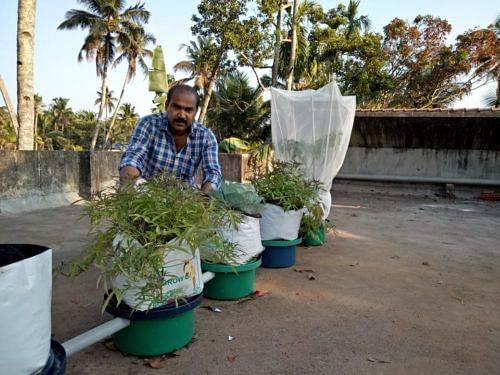
Watering the plants is one of the most important daily tasks when it comes to maintaining a garden or even a farm. It is not something that can be overlooked.
Biju Jala of Karunagapally, Kottayam, has invented a low-cost irrigation system that is simple to put up and can water up to 10 plants on its own to make this procedure a bit easier for people. Furthermore, this method, which is great for grow bags, prevents flies and pests from harming the plant.
The Irrigation System
Biju Jalal worked as an accountant in the United Arab Emirates until 2010. He began putting his time and effort in farming only after returning to Kerala.
"When I returned to Kerala, I put up a terrace garden with about 20 grow bags filled with carrots, tomatoes, green chilies, and even several papaya varieties. I'd have to make time to water them at least twice a day because they were put up on the terrace. And it was then that I decided to use wick irrigation for my plants,” Biju explains.
A bucket is filled with water and then covered with a tray having an incision in the middle in a traditional wick irrigation system. A thick cotton wick is introduced via the incision. One end of the wick is in contact with the water, while the other end passes through the grow bag on top of the tray.
The plant will take in the needed amount of water in this manner. The only challenge is that you must constantly filling in the buckets with water.
Biju decided to make a few changes to this system in order to improve its efficiency. Instead of replenishing the buckets with water, he chose to connect them horizontally with PVC pipes. This could be connected to a water pipe eventually.
When the buckets ran out of water, the user could simply switch on the hose to re-fill them. All of the buckets would get an equal amount of water from the interconnected PVC pipes.
At expos and farming seminars, the system gained a lot of traction, but Biju received feedback that the lowering water levels were not visible. To address this problem, he enhanced the device by including a low-cost valve that can automatically pump water when the system is linked to the tank.
This wick irrigation system, which comprises of 10 interconnected buckets, costs as little as 3000 rupees per unit.
"I never imagined this method would become so well-known. I've sold over 20,000 of these units in the last eight months, and orders are still coming in!" Biju bursts claims.
Majudeen, who bought a unit in Kannur, Kerala, says it has enabled him produce a wide range of vegetables on his terrace, including beans and chilies. He continues, "The tray covering the water also assures that there is no infestation, which is a huge relief."
Grow Bags Tips
Despite the fact that the irrigation system makes maintenance much easier, Biju claims that the grow bags require a lot of monitoring.
Here are some suggestions Biju believes would help:
-
For at least two weeks, the soil in the grow bags must be completely dry. The soil must then be sprayed with water and dolomite on a regular basis (a mixture of magnesium and calcium). It will be ready to absorb the water after this.
-
The wick should be soaked in water for at least 10 minutes before being inserted into the grow bag.
-
To keep pests and insects at bay, use natural insecticides like garlic and neem leaves.
-
To reduce moisture loss, cover the exposed sections of the grow bag with dried leaves or paper if the grow bag is put in direct sunlight.
Biju says, "If a household has three units of this irrigation system, they can easily grow all the vegetables for a full year without any difficulty."
We hope Biju's technique has inspired you to give this irrigation system a try. Please let us know how well his advice worked for you.
















